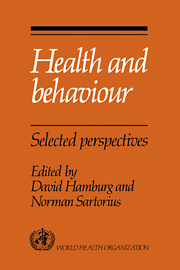Book contents
- Frontmatter
- Contents
- List of contributors
- Preface
- Acknowledgements
- List of abbreviations
- 1 Social and behavioural determinants of mental disorders
- 2 Food-related behaviour
- 3 The psychosocial environment and the development of competence in children
- 4 Children in danger
- 5 Adolescent health care and disease prevention in the Americas
- 6 Social networks and mental disorder (with special reference to the elderly)
- 7 Mental health aspects of general health care
- 8 The sociology of health care in developing countries
- 9 Population movements and health: global research needs
- 10 Health and behaviour: a worldwide perspective
- Index
5 - Adolescent health care and disease prevention in the Americas
Published online by Cambridge University Press: 06 August 2010
- Frontmatter
- Contents
- List of contributors
- Preface
- Acknowledgements
- List of abbreviations
- 1 Social and behavioural determinants of mental disorders
- 2 Food-related behaviour
- 3 The psychosocial environment and the development of competence in children
- 4 Children in danger
- 5 Adolescent health care and disease prevention in the Americas
- 6 Social networks and mental disorder (with special reference to the elderly)
- 7 Mental health aspects of general health care
- 8 The sociology of health care in developing countries
- 9 Population movements and health: global research needs
- 10 Health and behaviour: a worldwide perspective
- Index
Summary
In dealing with the subject of adolescence, problems of definition immediately arise. Some social scientists view adolescence as a recent cultural invention of the Industrial Revolution devised primarily as a lengthy transitional stage to keep young persons out of the labour market. This is not an adequate explanation. In a myriad of guises, adolescence is a significant developmental transition, which is recognized in all types of cultures, and whose evolutionary roots have been clearly described in systematic studies of non-human primates.
Adolescence has two major aspects, a biological one, and a sociocultural one. The biological changes of puberty mark the initiation or lower end of the adolescent period; the upper end or termination of the adolescence is marked by the induction of the individual into adult social roles and responsibilities. As a society becomes more and more complex, the timing of assumption of adult roles is increasingly delayed. In the most complex, affluent, and industrialized nations, the age limits defining adolescence may extend from age 10 through 20 or more years of age. The extension of time is largely at the upper end of adolescence and is due to postponement of assumption of adult roles; but in these same countries, there is an extension at the lower end as well.
The rate of biological maturation and the changes of puberty are related to the nutritional and overall health status of the individual, and studies in several Western nations have demonstrated a secular trend toward lowering the age of menarche (the sentinel event of pubertal maturation) by three months per decade.
Keywords
- Type
- Chapter
- Information
- Health and BehaviourSelected Perspectives, pp. 127 - 149Publisher: Cambridge University PressPrint publication year: 1989



